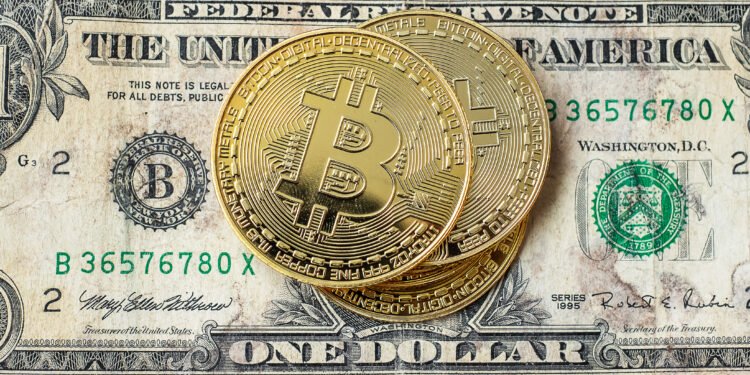The financial markets are embarking on an unprecedented experiment that could fundamentally reshape our understanding of how digital assets interact with traditional monetary systems. President Donald Trump’s recent signing of the GENIUS Act has set the stage for what may become one of the most significant tests of cryptocurrency’s influence on established financial markets, specifically its potential to bolster demand for U.S. dollars and Treasury securities.
The landmark legislation, signed in a ceremonial East Room event at the White House on Friday, July 18, 2025, represents far more than simple regulatory clarity for the burgeoning stablecoin market. It establishes a direct financial pipeline between the rapidly expanding world of digital assets and the foundational instruments of American monetary power. The question now looming over financial markets is whether the cryptocurrency ecosystem has achieved sufficient scale to meaningfully influence the price dynamics of U.S. bonds and the dollar’s global standing.
The Genesis of a New Financial Architecture
The GENIUS Act, formally known as the “Guiding and Establishing National Innovation for U.S. Stablecoins” legislation, creates the first comprehensive federal regulatory framework for stablecoin issuers in the United States. More importantly for broader financial markets, it mandates that all U.S. stablecoins maintain 100% reserve backing using only U.S. dollars or short-term Treasury securities. This requirement effectively transforms stablecoin issuers into quasi money market funds, channeling potentially vast sums of international liquidity directly into dollar-denominated assets.
The immediate market reaction to the legislation’s passage and Trump’s signature has provided early indications of the potential magnitude of this shift. Bitcoin surged to approximately $119,000 per coin, representing a 1.27% gain that pushed the world’s largest cryptocurrency to within striking distance of new all-time highs. Perhaps even more significantly, Ethereum experienced a dramatic rally, climbing nearly 12% over the five-day period leading up to and following the bill’s enactment.
These gains occurred against the backdrop of a modest but notable recovery in the U.S. dollar itself. After experiencing a steep 10.8% decline year-to-date at the beginning of July, the dollar has managed to claw back some ground, with losses now standing at 9.39% for the year. While this recovery remains limited in scope, it suggests that markets are beginning to price in the potential demand implications of the new stablecoin regulations.
The Stablecoin-Treasury Nexus
To understand the potential impact of the GENIUS Act on traditional financial markets, it’s essential to grasp the mechanics of how stablecoins operate and why their regulatory treatment matters so significantly for Treasury demand. Stablecoins are digital assets designed to maintain a stable value relative to a reference currency, typically the U.S. dollar. This stability is achieved through various mechanisms, but the most common approach involves backing each digital token with reserves of fiat currency or equivalent assets.
The GENIUS Act’s reserve requirements represent a significant tightening of standards for stablecoin issuers operating in the United States. By mandating that reserves consist exclusively of dollars or U.S. Treasuries, the legislation eliminates the possibility of backing stablecoins with other assets such as commercial paper, corporate bonds, or foreign currencies. This creates a direct and unavoidable link between stablecoin growth and demand for the safest dollar-denominated assets available in global markets.
The implications of this linkage become clear when considering the current scale of the stablecoin market and its projected growth trajectory. Deutsche Bank analysts Marion Laboure and Camilla Siazon noted in a client communication that the legislation “formalizes stablecoin issuers’ role as quasi money market funds, supporting US short-term debt markets and channeling non-USD liquidity into dollars.” This transformation occurs at a time when questions about U.S. dollar hegemony have intensified, making the potential reinforcement of dollar demand through digital channels particularly significant for policymakers.
The scale of this potential impact is already visible in the holdings of major stablecoin issuers. Tether, the world’s largest stablecoin issuer, holds over $120 billion in Treasury bills as of the first quarter of 2025, ranking among the top holders of U.S. Treasuries globally. This massive accumulation of government debt by a single digital asset company illustrates the potential magnitude of the Treasury demand that could emerge from broader stablecoin adoption.
Projecting Future Treasury Demand
The U.S. Treasury Department has begun modeling the potential scale of stablecoin-driven demand for government securities, and the projections are striking in their magnitude. According to Treasury estimates, T-bills held by stablecoin issuers could grow to approximately $1 trillion by 2028, excluding interest-bearing stablecoins from this calculation. This projection assumes continued growth in stablecoin adoption, regulatory compliance with the GENIUS Act’s requirements, and expansion of the overall digital asset ecosystem.
To put this trillion-dollar projection in perspective, it would represent a substantial portion of the total Treasury market and would position stablecoin issuers collectively among the largest categories of Treasury holders globally. For comparison, Japan, currently the largest foreign holder of U.S. Treasuries, holds approximately $1.1 trillion in U.S. government securities. The prospect of stablecoin issuers collectively reaching similar levels of holdings suggests a potential fundamental shift in the composition of Treasury demand.
This growth trajectory reflects not just expansion in the stablecoin market itself, but also the geographic diversification of digital asset adoption. Stablecoins have found particular utility in countries experiencing currency instability, capital controls, or limited access to traditional banking services. As these use cases continue to develop and expand globally, the underlying demand for dollar-backed stablecoins could drive corresponding increases in Treasury purchases by issuers seeking to maintain full reserve backing.
Market Dynamics and Yield Implications
The GENIUS Act’s prohibition on stablecoin issuers offering yield to token holders introduces another layer of complexity to the market dynamics surrounding digital assets and traditional finance. This restriction, designed to prevent stablecoins from competing directly with traditional deposit products, has created interesting spillover effects in other segments of the cryptocurrency market.
The elimination of yield-bearing stablecoins appears to be driving investor interest toward alternative sources of returns within the digital asset ecosystem. Ethereum has emerged as a primary beneficiary of this shift, with its proof-of-stake consensus mechanism offering “staking” rewards to users who help secure the network. This dynamic helps explain Ethereum’s particularly strong performance following the GENIUS Act’s passage, as investors sought alternative sources of yield within the cryptocurrency space.
The implications of removing yield from stablecoins extend beyond simply redirecting investment flows within crypto markets. By requiring stablecoin reserves to be held in non-yielding cash or low-yielding short-term Treasuries, the legislation effectively concentrates the economic benefits of these reserves with the issuing companies rather than distributing them to token holders. This concentration creates powerful incentives for companies to enter the stablecoin issuance business, potentially accelerating the growth of dollar-backed digital assets.
Geopolitical and Strategic Implications
President Trump’s emphasis on the dollar’s reserve currency status during the GENIUS Act signing ceremony reflects broader geopolitical considerations underlying the legislation. The president stated that the Act would “secure the dollar’s status as the world reserve currency,” and added that losing reserve status would be equivalent to the United States “losing a world war.” This dramatic language underscores the strategic importance that policymakers place on maintaining dollar dominance in an increasingly multipolar global economy.
The timing of this legislation comes amid growing concerns about de-dollarization efforts by various countries and the potential emergence of alternative reserve currencies or payment systems. By channeling the growth of digital assets toward dollar-denominated reserves, the GENIUS Act represents an attempt to harness technological innovation in service of traditional monetary objectives.
The strategic implications extend beyond simple market mechanics to encompass broader questions about financial sovereignty and technological competitiveness. Countries that have been developing their own central bank digital currencies (CBDCs) or alternative payment systems may find their efforts complicated by the growing international adoption of dollar-backed stablecoins. If stablecoins backed by U.S. Treasuries become the dominant form of digital money globally, they could reinforce rather than challenge existing monetary hierarchies.
Testing the Scale Hypothesis
The central question raised by these developments concerns whether the cryptocurrency market has achieved sufficient scale to meaningfully influence the prices of U.S. bonds and the dollar. While the preliminary market reactions to the GENIUS Act suggest some impact, the true test will come as the legislation’s requirements are implemented and stablecoin adoption continues to expand.
Several factors will determine the ultimate magnitude of this impact. The growth rate of stablecoin adoption, both domestically and internationally, will directly influence the scale of Treasury demand. Regulatory developments in other major economies could either complement or compete with U.S. stablecoin regulations, affecting the global distribution of digital asset reserves. Additionally, the development of alternative blockchain technologies and payment systems could influence whether dollar-backed stablecoins maintain their current market dominance.
The current market capitalization of the stablecoin sector, while substantial at approximately $250 billion, remains relatively modest compared to the overall Treasury market. However, the growth trajectory of digital assets and their increasing integration with traditional financial systems suggest that their influence on bond and currency markets may expand significantly in coming years.
Implementation Challenges and Opportunities
The practical implementation of the GENIUS Act’s requirements will present both challenges and opportunities for market participants. Stablecoin issuers must now navigate the transition to full Treasury backing while maintaining the operational efficiency that has made their products attractive to users. This transition may involve significant changes to business models, operational procedures, and risk management frameworks.
For traditional financial institutions, the legislation creates new opportunities to participate in the stablecoin ecosystem. Banks, credit unions, and other regulated financial entities can now issue their own stablecoins under the new framework, potentially capturing some of the economic benefits that have accrued to crypto-native companies. This expansion of potential issuers could accelerate the overall growth of the stablecoin market and corresponding Treasury demand.
The Federal Reserve and Office of the Comptroller of the Currency, designated as the primary regulators for large stablecoin issuers under the Act, face the challenge of developing effective oversight mechanisms for this new category of financial institution. Their approach to supervision and enforcement will significantly influence how quickly and extensively the stablecoin market develops under the new regulatory framework.
Global Implications and Competitive Responses
The GENIUS Act’s impact extends beyond U.S. financial markets to influence global monetary and financial systems. Other major economies are closely watching the American approach to stablecoin regulation, with some likely to develop competing frameworks designed to attract digital asset activity to their own jurisdictions.
The European Union’s Markets in Crypto-Assets (MiCA) regulation, which has already led some major exchanges to delist Tether’s USDT, represents one alternative approach to digital asset regulation. The divergence between U.S. and European regulatory frameworks could lead to the development of parallel digital asset ecosystems, each with different reserve backing requirements and corresponding impacts on sovereign debt markets.
Emerging economies, particularly those experiencing currency instability or seeking to develop their financial technology sectors, may view stablecoin adoption as an opportunity to access dollar liquidity while building domestic digital payment infrastructure. The GENIUS Act’s requirements could make U.S.-compliant stablecoins particularly attractive in these markets, potentially extending the reach of dollar-denominated assets into economies where traditional banking relationships remain limited.
Looking Forward: The Evolution of Digital-Traditional Finance Integration
The signing of the GENIUS Act marks a significant milestone in the integration of digital assets with traditional financial systems, but it represents just the beginning of a broader transformation. As stablecoin adoption grows and their impact on Treasury markets becomes more pronounced, additional policy responses and regulatory refinements are likely to emerge.
The success of this experiment in harnessing digital asset growth to support traditional monetary objectives will influence how other countries approach the regulation of digital assets and the development of their own digital currency initiatives. It may also affect the broader trajectory of cryptocurrency development, potentially steering innovation toward use cases that complement rather than compete with existing monetary systems.
For investors and market participants, the GENIUS Act creates new dynamics that will require careful monitoring and analysis. The interplay between cryptocurrency market developments and traditional bond and currency markets adds layers of complexity to investment decision-making and risk management. Understanding these connections will become increasingly important as the scale of digital asset markets continues to expand.
Conclusion: A Pivotal Moment for Financial Markets
The enactment of the GENIUS Act represents a pivotal moment in the evolution of both cryptocurrency markets and traditional finance. By creating direct linkages between digital asset growth and demand for U.S. dollars and Treasuries, the legislation establishes a framework that could significantly influence global financial markets in the years ahead.
Whether this experiment succeeds in meaningfully supporting the dollar’s reserve currency status and creating sustained demand for U.S. government securities will depend on numerous factors, including the pace of stablecoin adoption, competitive regulatory responses from other countries, and the broader evolution of digital payment technologies. The early market reactions suggest that investors are beginning to price in the potential implications, but the full impact will only become clear as the legislation’s requirements are implemented and the stablecoin market continues to mature.
What remains certain is that the boundaries between digital assets and traditional finance are becoming increasingly blurred. The GENIUS Act represents just one example of how policymakers are working to harness technological innovation in service of established economic and strategic objectives. As this integration continues to deepen, understanding the connections between cryptocurrency markets and traditional financial instruments will become essential for anyone seeking to navigate the evolving landscape of global finance.
The question of whether crypto markets are large enough to influence bond and dollar prices is in the process of being answered through real-world market dynamics rather than theoretical speculation. The results of this ongoing experiment will have implications that extend far beyond the digital asset space to touch the very foundations of international monetary systems and financial stability.







